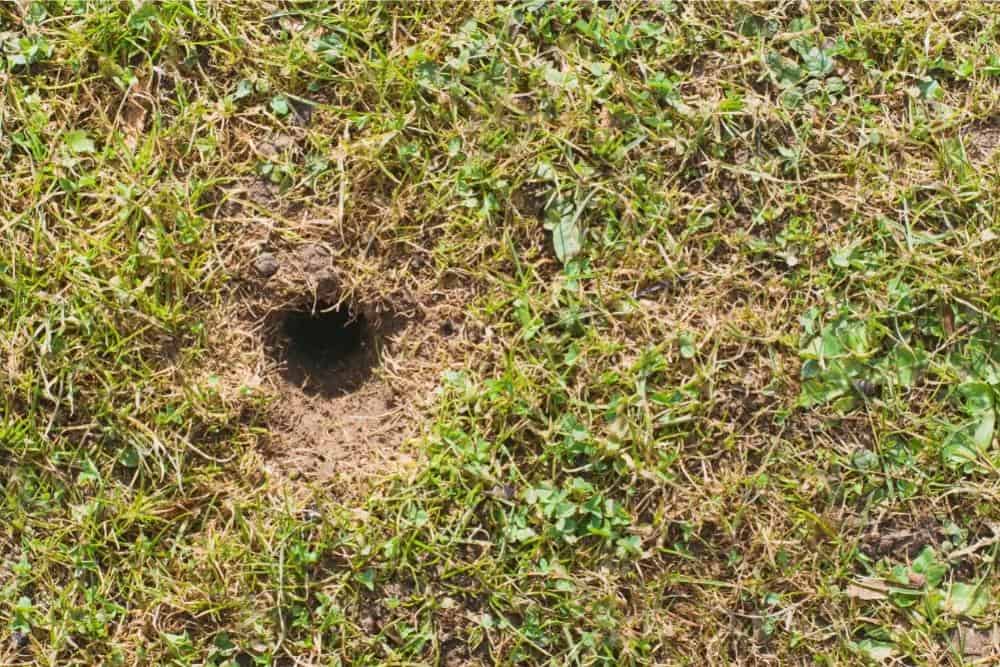Investing time, money, and effort into a lush green lawn only to discover unsightly holes can be disheartening. These disturbances may indicate a pest issue that demands attention.
Quick Answer
If your four-legged friend isn’t the culprit, the animals digging small holes in your yard can be unwelcome visitors such as moles, gophers, voles, rats, birds, or even insects like wasps.
Identifying the cause of these holes is crucial before attempting any remediation. This guide offers a comprehensive approach to diagnosing and addressing yard holes, emphasizing the importance of identifying the specific pest before implementing a solution.

What Animal Is Digging Holes in My Yard?
Finding what animal is digging holes in the yard is important as this will allow you to put in place the correct preventative measures.
As I’ve mentioned earlier, most small holes will likely be caused by insects or small rodents, and depending on which animal is digging the hole, they will differ significantly in size.
I’m going to walk you through a few of the animals that could be causing your problem.
1. Small Earthworm Holes
These are tub-shaped, legless, segmented worms and can be found in the soil in every yard. They are a normal (and essential) part of your lawn as they can dig small holes in the yard that introduce air into the lawn as they turn over the soil and feed it.
However, an abundance of earthworms living in the soil underneath your lawn will create multiple holes along with little piles of granular pellets of soil. These holes will poke through the top of the pile of soil.
Earthworm holes are more common in the spring than in the fall and are especially common when the temperature is warm and the soil is moist.
To get rid of these pests, you should avoid killing them. This is because earthworms are beneficial to the turf in several ways.
But if you want to remove earthworm holes, simply lower the soil pH and remove the food sources such as clippings and fallen leaves and top dressing with sand.
2. Voles
Voles, also known as meadow mice can also be the main culprit to holes in the yard but the good thing is that you’ll know the signs pretty easily.
If you find rodent droppings alongside chewed grass clippings or a trail of dead grass, then it’s more than likely voles.
Sometimes field mice may take up residence in the vole holes and the best way of identifying this is by examining the droppings. The waste of a field mouse is usually oval-shaped so keep an eye out for this.
Even though both voles and moles possess tunneling habits, voles make tunnels that aren’t raised whereas moles dig visibly raised tunnel ridges.
3. Moles
Moles barely leave an opening to their holes and tend to feed on grubs or other soil organisms such as earthworms. They dig tunnels that reach about 16-18 inches deep below your lawn.
The holes will have a mound of soil on top that measures around 5 – 7 inches long and are shaped like a volcano. Moles rarely appear on your lawn however unless they are looking for a mate.
To stop moles digging at your turf, repel them using a natural repellent such as the Natural Elements Mole and Vole Repellent and if the problem persists, plant some natural mole repellents around your yard.
Natural mole repellents include marigolds, shallots, garlic, daffodils, fritillaries or alliums.
4. Rats
Rats tend to make holes near tree snags, big roots, or fences, There will usually be signs of gnawing, and soil that was thrown out of the holes by the pests will be left outside. Holes made by rats are usually about 3 inches wide and will show activity near the opening.
A lot of rat holes could be an early sign of a rat infestation. To get rid of them, clear the bushes, mow any overgrown grass, and remove any open food sources. You can also apply a natural rat repellent.
5. Gophers
Gophers are easy to spot due to the mound of dirt they create from digging their holes. As they are herbivores, you’ll also see signs of vegetation damage. They eat the roots and the blades of your grass so you are likely to find grass blades in the tunnels.
Apart from the holes ruining the look of your lawn, unfortunately, the tunnels that gophers make can affect the structural integrity of your turf which means you’ll end up with uneven ground levels.
To stop these rodents, repel them with castor oil pellets. If you don’t have castor oil pellets to hand, however, use some kind of fabric softener or peppermint oil into their burrows to force them to leave the yard.
6. Insects
Insects often live in the ground during colder months and emerge during springtime. This happens when they are in a larval stage and as they emerge into the open air, they can leave small holes behind.
An example of insects that do this is cicadas and Japanese beetles. Japanese beetles bury their eggs into the soil and their eggs hatch into larvae. When they mature into beetles, this is when they start to emerge.
They also feed on grass roots during their larvae stages and bring even more trouble to your lawn by attracting other animals such as wasps, armadillos, birds, and raccoons.
These animals cause even more damage to your lawn as they tend to dig up to extract the larvae of Japanese beetles.
Moreover, some wasps and cicada killer wasps, as well as the scoliid wasps, dig holes when the grass is relatively short and the ground has been exposed.
Scoliid wasps, in particular, dig holes to lay eggs while killer wasps dig holes to bury paralyzed cicadas alongside their eggs to nourish their babies once hatched.
Ants and termites could also be your culprits but you will only need to control these pests if the damage is extensive and visible.
7. Chipmunks And Squirrels
Chipmunks and squirrels can cause a number of small holes across your lawn. Squirrels dig up and bury their nuts in your yard so that they remain hidden for later use.
Eastern gray squirrels are usually the cause of your holes and these holes are shallow, small, and usually do not have a mound of soil around them.
If you have nutsedge weed in your lawn, squirrels may dig this up to get the tubers and feed on these too.
Chipmunks dig their holes to hide. They hide in their holes away from danger and can be found in areas with log piles, buildings, or stumps.
8. Armadillos
Armadillos are usually the only cause of holes in your lawn if they are common in your area. Since they tend to feed on small invertebrates such as grubs and insects, they will dig shallow holes to locate their food.
To identify whether your holes are being caused by armadillos, you can check to see if you have any ants or grubs living on your lawn. Ants will create small holes with ant hills in your yard and grubs eat the roots of your grass which causes irregular brown patches of dead grass.
9. Birds
When you notice a lot of birds flying around your yard, the chances are that they are feeding on lawn pests. Grubs and ants attract birds and you’ll therefore notice birds digging small holes with their beaks and claws so that they can locate their food.
Most birds will dig and feed early in the morning. As we all know – the early bird catches the worm! To prevent bird holes, you need to control the grubs and ants in your yard first.
10. Snakes
To identify a snake hole, look out for holes that are circular and might even have snakeskin that have been shed on the grass surrounding them.
However, in most cases the holes are usually left by more common vertebrate pests such as moles or rats so don’t jump straight into panic and think you’ve got a snake problem if you wake up to holes one morning.
11. Crayfish
Sounds crazy right? Well, it’s not. If you live near any sort of water area, there is a large chance that your holes are being created by crayfish.
To identify a crayfish hole, look out for tower-like holes. They use mud balls to create these holes, which are about 3 inches high and 2 inches in diameter.
12. Pets
One of the most destructive behaviors that your dog will do is to dig holes in your yard and ruin that beautiful lawn.
We all know they are only playing and just trying to have some fun but sometimes it’s more than just frustrating. What’s more is that whilst they are out there, if they decide to urinate on the lawn too, this can also end up killing it.
Despite not being able to keep your dog off the lawn, you can train them not to urinate on the grass and when it comes to the holes, you’re simply just going to have to act fast and fill them quickly.
13. Children
Not only can pets cause these holes but children can too. Young children love to play just as much as your pets do and sometimes digging holes can be an extremely fun activity for them.
To stop this, simply talk to them and explain how digging holes can ruin the lawn that means so much to you. Perhaps offer them a sandpit or an alternate digging area instead.
How To Fill The Small Holes in Lawn Overnight?

Now that I have identified what might be causing the holes, it’s time to move on to how to fix them. The method you choose will depend on how many holes there are and how big they are.
If you are only filling one or two holes that may have been dug by a dog or a child, get yourself some dirt or topsoil and manually put it in the hole.
Press it down hard before stepping on it to make it firm. Next, rake the scattered soil that is remaining into the crevices all over your lawn.
In certain cases, the holes can be rather large and this might do some damage to your lawn. You will in this case need to use an alternate method to reverse this damage and level the holes out.
For the first step of this method, you will need to pry the sunken grass up using a flat shovel before cutting the sunken areas up into square 1-foot square sods using the shovel.
You’ll then need to fill up the holes with new topsoil and replace the grass sods before pressing down on them with your foot or with a roller.
If this doesn’t work or if the damage is too much, I know this may be stressful and not what you want to hear but it’s time to start thinking about starting your lawn afresh and re-establishing the whole thing.
This will call for you to start with pest control, before tearing down the remaining lawn. You will then need to plant new grass or lay new sod.
Final Thoughts
I hope by reading this article, you’re no longer scared of waking up to find holes in your lawn but feel more than prepared to take them on.
Yes, finding holes is never a good sign and usually indicates a pest problem you’re going to have to deal with but if you follow our simple steps, you’ll hopefully be looking out to see that lush green lawn again in no time.
If you identify the cause, act fast, and follow our instructions, you should be able to get rid of the holes all by yourself, but don’t be afraid to start afresh as this will sometimes be more beneficial in the long run and if the problem is beyond your capabilities, always call a pest control service.
Hi, Alex Kuritz here. Growing up I remember that my family had one of the best lawns in the neighborhood. Richly green and lush. I did a lot as I grew up in terms of caring and tending for not only my family’s lawn but also my neighbors. I can say I have years of experience, and I am here to share it with you.


